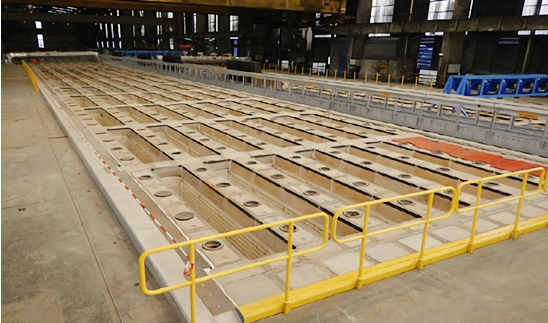- 28
- Nov
Various masonry quality problems of carbon calciner and their preventive measures
Various masonry quality problems of carbon calciner and their preventive measures
The problems and prevention in the process of carbon calcining furnace masonry will be shared by refractory brick manufacturers.

1. The thickness of the expansion joint of refractory brick is too large:
(1) The refractory mud has a large particle size, which affects the masonry quality, and a small particle size refractory mud of the corresponding material should be selected.
(2) Refractory bricks have inconsistent specifications and uneven thickness. The bricks should be selected strictly. Defective refractory bricks such as missing corners, bends and cracks should not be used, and the joint size of the bricks should be adjusted with refractory mortar.
(3) The refractory slurry has a large viscosity, insufficient beating, and weak ductility. When preparing the refractory slurry, the water consumption should be controlled, thoroughly stirred, and often evenly stirred during use.
(4) When the masonry is not drawn, it will cause the masonry elevation, levelness and expansion joint size to fail to meet the design and construction requirements. In order to ensure the quality of masonry, it is necessary to pull the line to assist the masonry work.
2. The problem of insufficient filling of refractory mud:
(1) The refractory mud is not extruded during bricklaying, and the amount of mud is too small, so a sufficient amount of refractory mud should be used for masonry.
(2) The laying of refractory mortar is not even enough. When beating the surface of refractory bricks, it should be as uniform as possible.
(3) Put the bricks in place improperly. After the refractory bricks are placed, they should be rubbed several times to squeeze out the excess refractory mud and ensure that the size of the brick joints is qualified and correct.
(4) Too wet or too dry during squeegee; prevention method: be sure to master the degree of dryness and wetness of squeegee.
(5) The shape of the refractory brick is irregular, which causes the mud to not be evenly attached to the brick surface. The size of the refractory brick should be strictly screened.
3. The problem of uneven size of expansion joints:
(1) The thickness of refractory bricks is uneven, and qualified refractory bricks should be screened. Those that can be treated with slurry can be leveled with refractory slurry.
(2) The beating process is more and sometimes less, and the amount of each time is different, and the number of operations should be performed to ensure that the amount of mud is consistent.
(3) For bricklaying without cables, cables must be used for masonry to ensure that the horizontal elevation of each layer of masonry meets the design and construction requirements.
(4) The size of the expansion joint is large and small, and the joint thickness of each refractory brick should be strictly controlled.
(5) The refractory slurry is not uniformly stirred. During the preparation process, strictly control the gray-water ratio, adjust the viscosity, and often stir during use.
4. The problem of uneven thickness of the upper and lower expansion joints:
(1) As a result of failure to carry out cable-assisted masonry work, the cable-drawing operation should be strictly controlled and clearly marked.
(2) The horizontal joints of the masonry are not leveled, and the horizontal elevation of each layer of masonry and the leveling treatment are strictly controlled.
5. The problem of uneven height of rectangular furnace wall:
(1) The corner masonry is not standardized, and experienced users should be used to build the corner.
(2) When masonry is not stretched, the masonry should be stretched to ensure the level of each layer of refractory bricks.
(3) When there are two or more people before and after the masonry, the construction methods are different, and the thickness and size of the refractory mortar are not the same. The masonry operation method of each construction worker should be standardized to ensure the uniformity of the masonry quality and the size of the brick joints. .
(4) The refractory slurry is not uniformly stirred. During the preparation process, strictly control the gray-water ratio, adjust the viscosity, and often stir during use.
(5) Wet refractory bricks or after being exposed to rain will no longer absorb the moisture in refractory mud. Do not use damp refractory bricks for masonry. After being drenched in rain, the refractory bricks must be dried before use.
6. The problem of uneven or parallel height of symmetrical arch feet:
(1) When masonry is not stretched, the masonry should be stretched to ensure the level of each layer of refractory bricks.
(2) The size of expansion joints is not uniform, so the joint thickness of each refractory brick should be strictly controlled.
(3) The two symmetrical furnace walls have not been simultaneously built, because they are easy to cause different heights due to successive masonry. If the front and rear masonry is built, the size of the joints of each layer of refractory bricks should be strictly controlled.
(4) When the two walls are built, the degree of dryness and wetness of the refractory bricks used is different. The damp refractory bricks shall not be used for masonry, and should be used after drying.
(5) When there are two or more people building two walls, the construction methods are different, and the thickness of the refractory mortar is not the same. The masonry operation method of each constructor should be standardized to ensure the quality of the masonry and the size of the brick joints. Unite.
